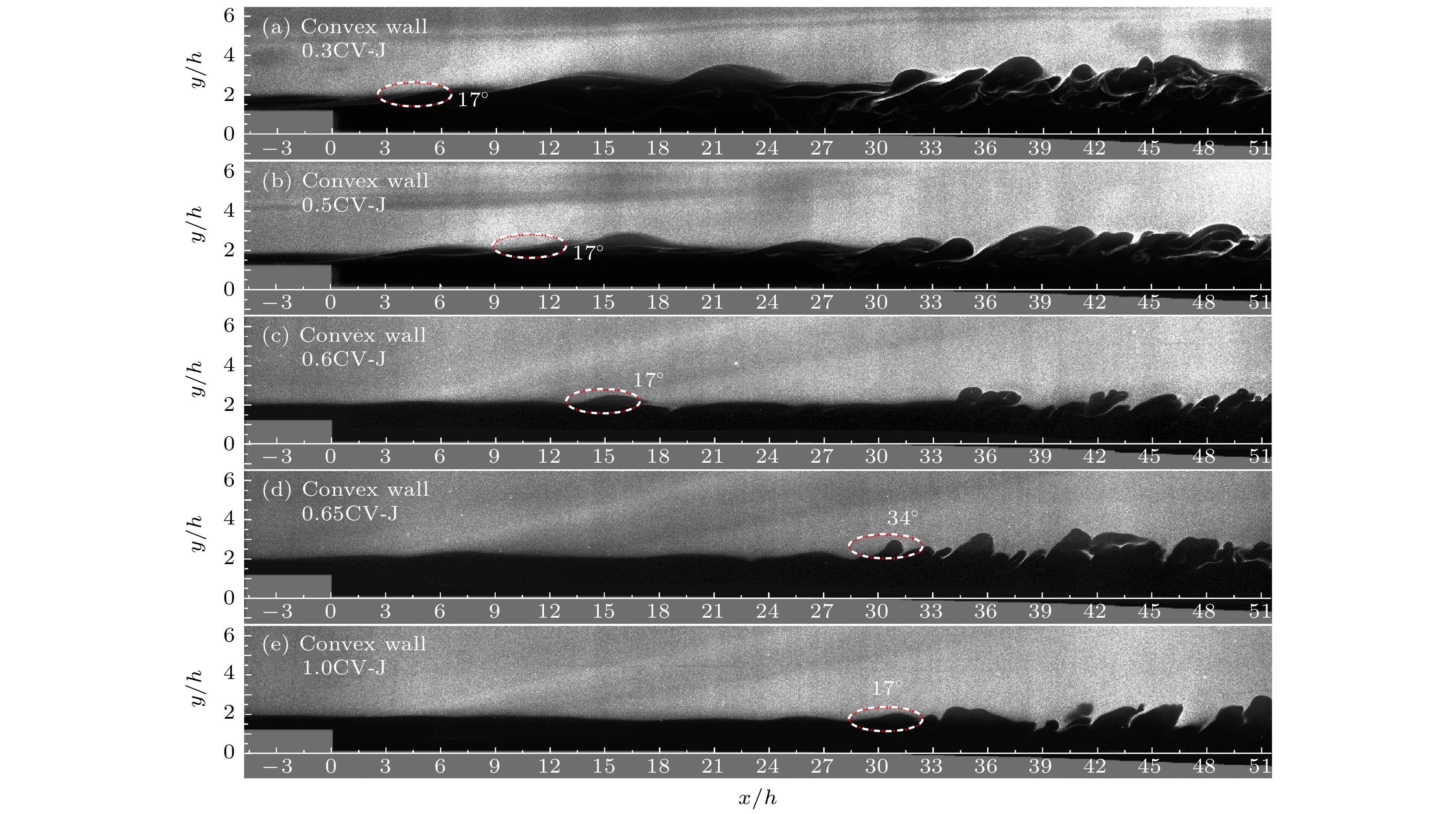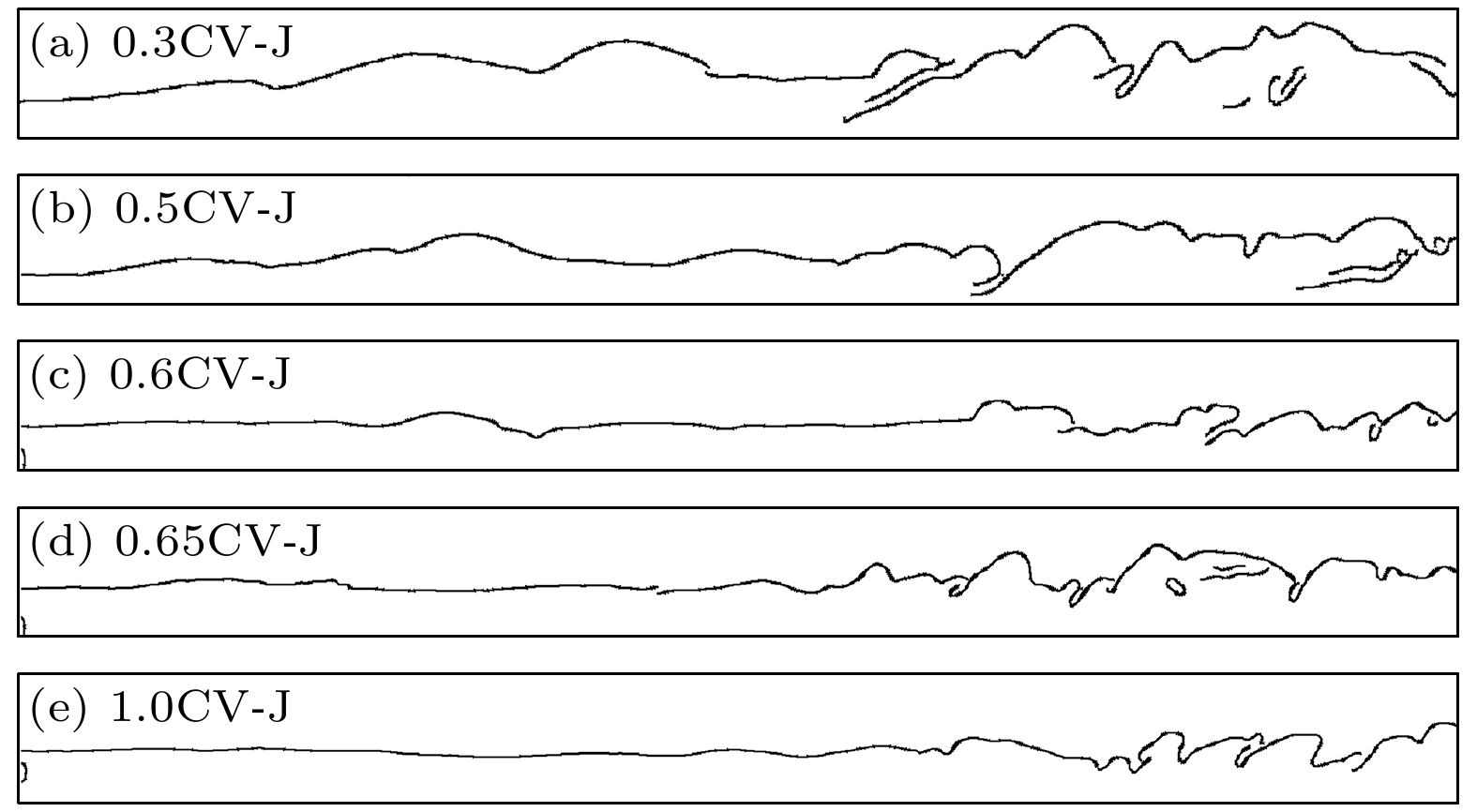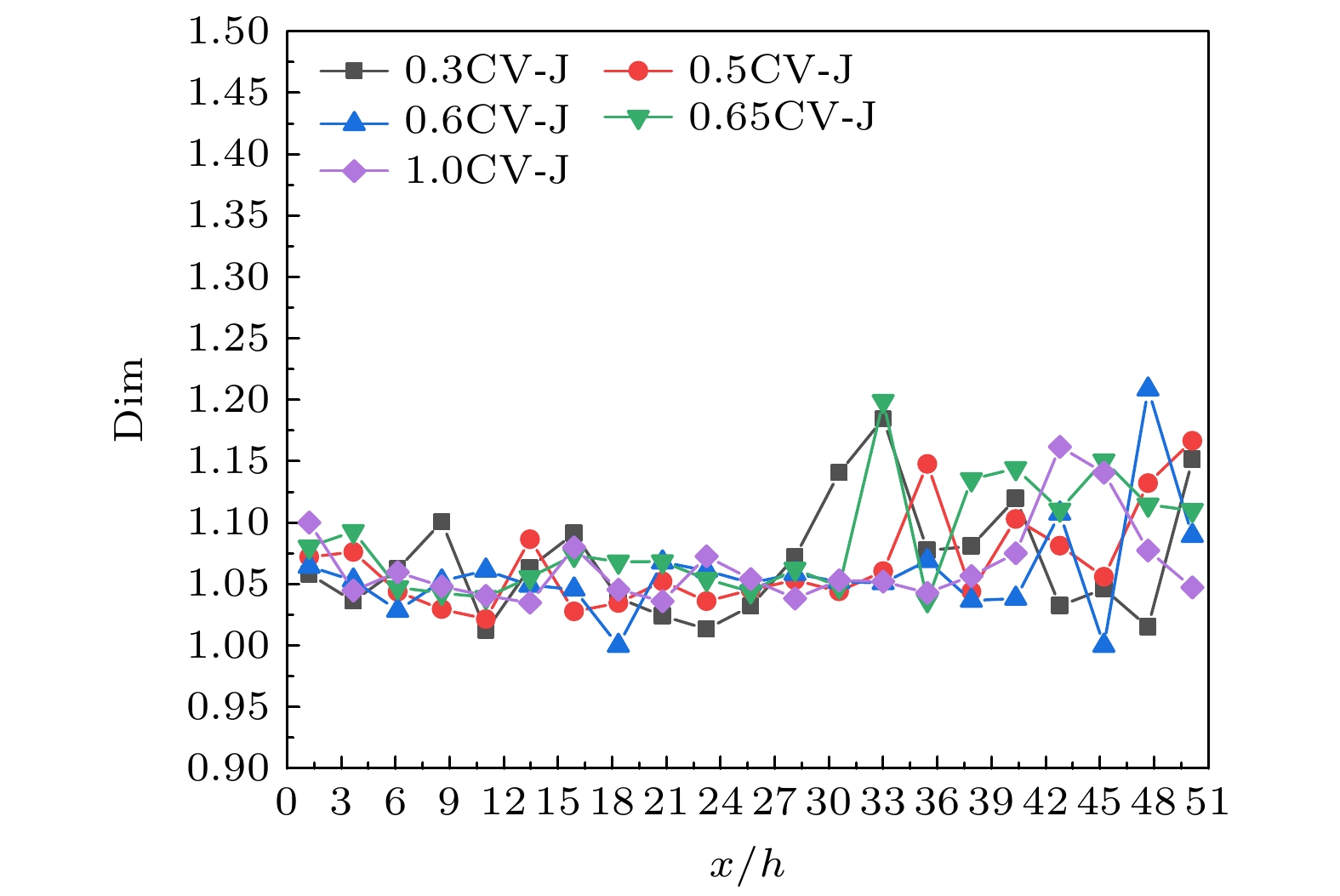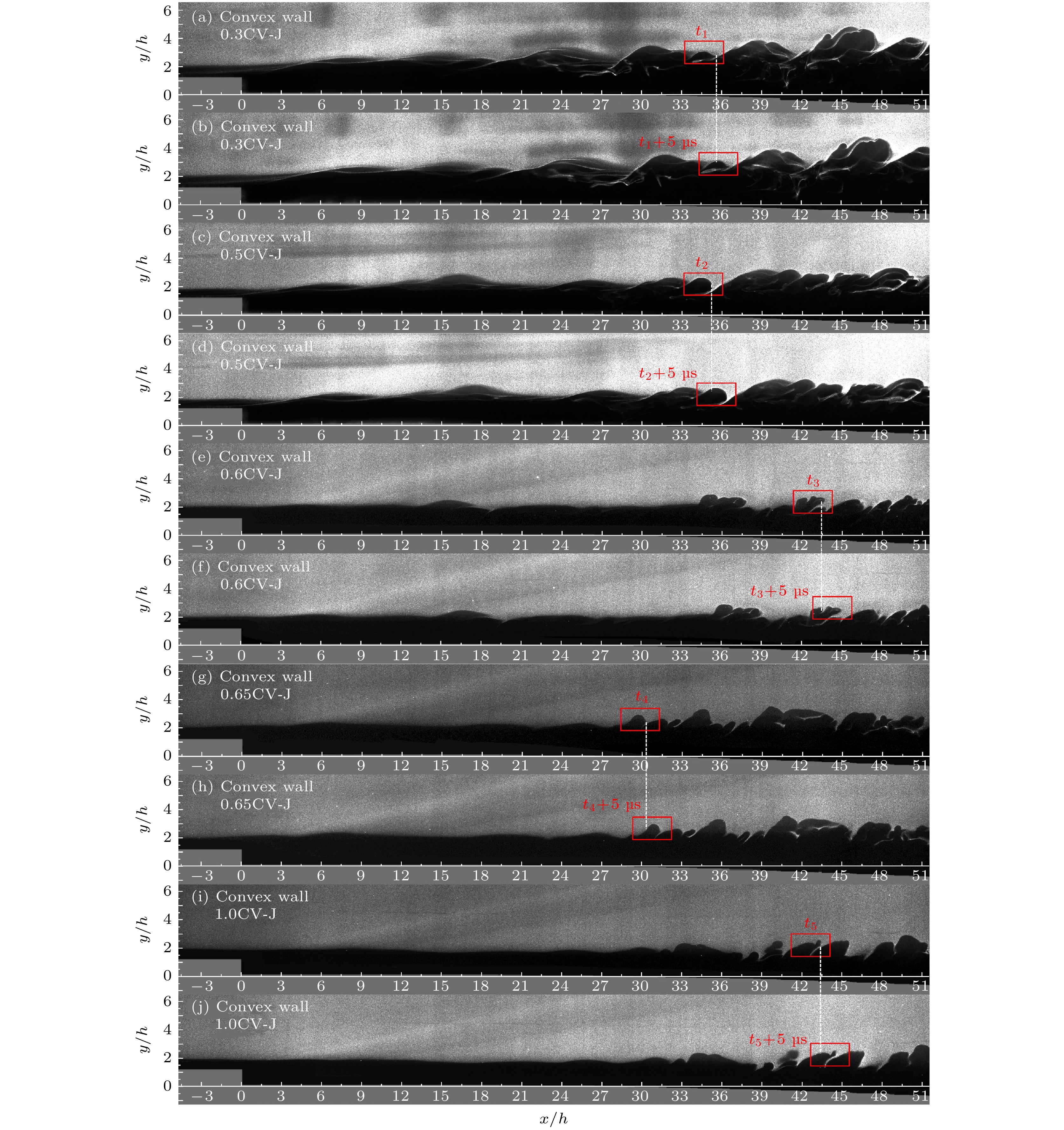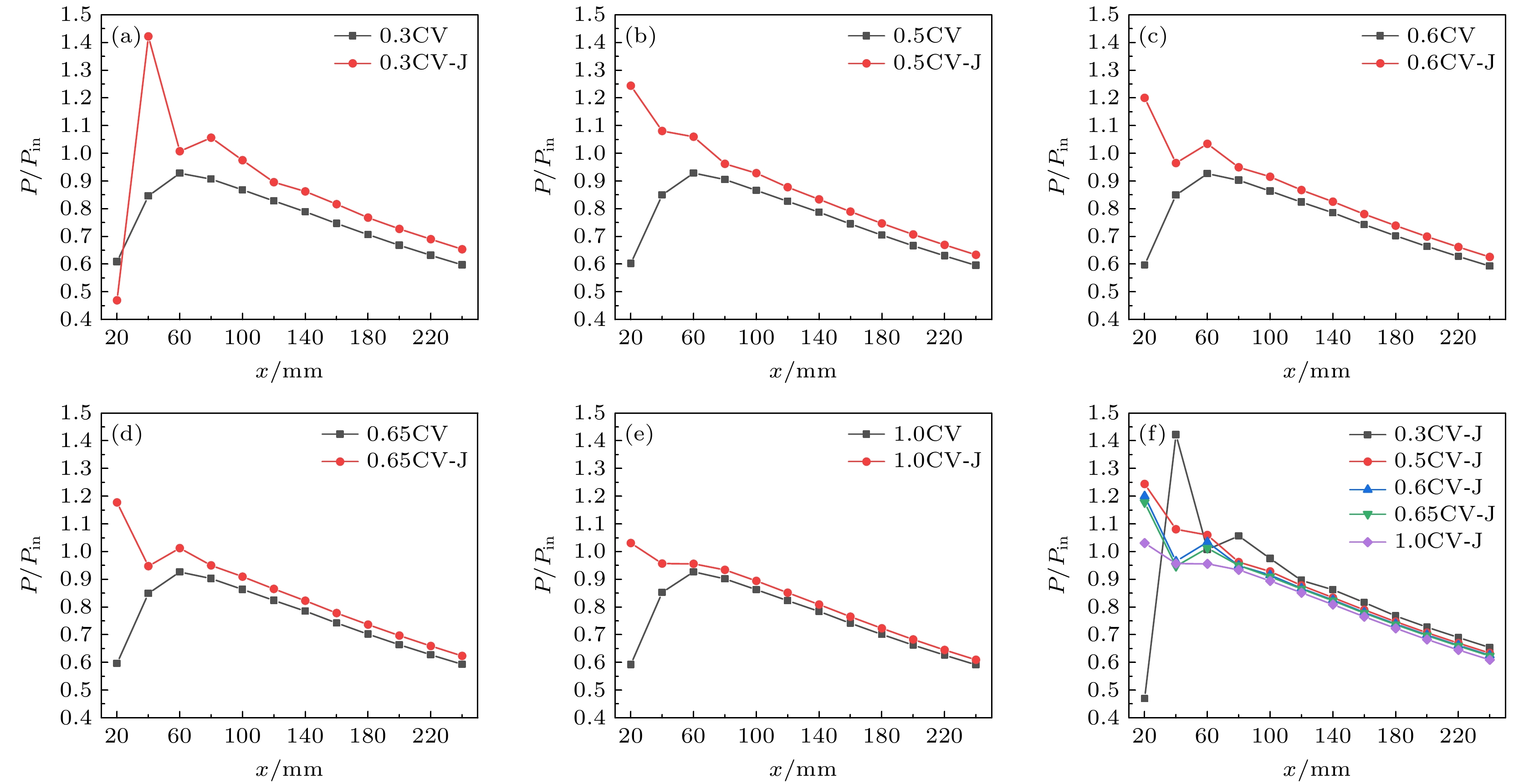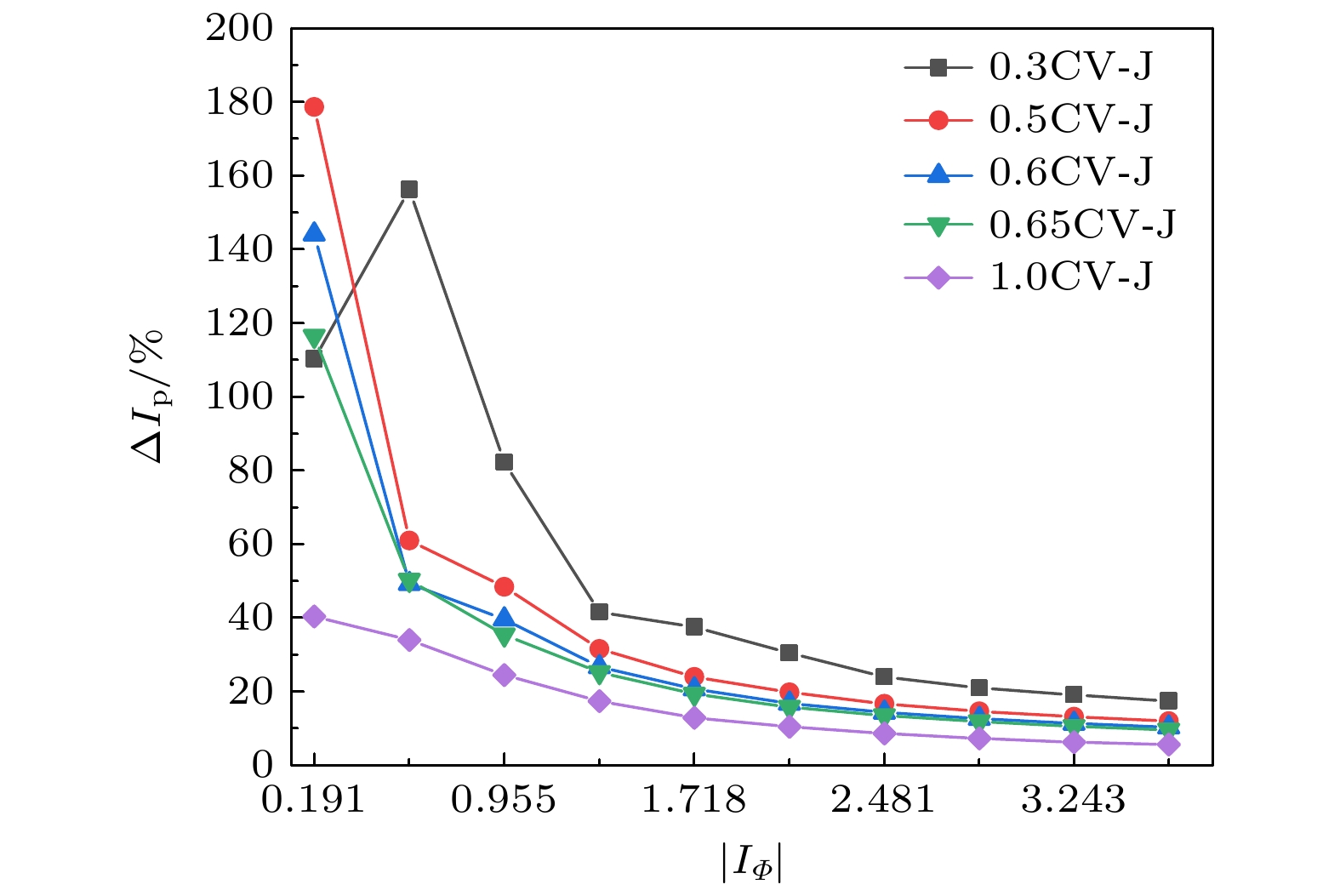-
随着高超声速飞行器的不断更新换代, 对成像窗口提出了新的设计要求, 即共形窗口以提高气动特性, 这要求在超声速气膜和光学窗口需要与飞行器机身保持相同的曲率外形. 在马赫数Ma = 6高超声速静风洞中开展了凸曲率壁面(CV)混合层稳定性研究. 采用基于纳米粒子的平面激光散射技术捕获到混合层流场结构, 结合分形维数对混合层失稳规律进行研究. 使用数值模拟技术得到了压力、压缩冲量(Ip)沿流向演化结果. 结果表明: 随着来流总压(P0)的增大, 静压比(RSP)减小, 混合层失稳位置延迟, 典型涡结构移动速度增大. CV壁面由于顺压梯度的存在使得压力沿流向下降, 沿壁面切向的超声速气膜处于工作状态时, 可以提升壁面压力, 随着P0增大, RSP随之降低, 提升效果下降; 流动受到CV的膨胀效应影响, Ip沿流向下降, 超声速气膜可以削弱CV上的膨胀效应从而抑制Ip的下降; 压缩冲量的变化率ΔIp受P0影响显著, 在弯曲冲量|IΦ| = 0.191—3.624内, 当P0 = 0.5 MPa, ΔIp从178.67%降至12.02%; 当P0 = 1.0 MPa, ΔIp从40.38%降至5.64%. ΔIp随|IΦ|增大而降低, 随着P0增大, 降低幅度减小. 结果揭示凸曲率影响下的高超声速混合层流动演化规律, 对高超声速飞行器实现气动减阻与防热特性的外形设计提供一定参考.With the continuous upgrading of hypersonic vehicles, a new requirement for designing imaging window i.e. conformal window for improving aerodynamic characteristics, is put forward, in which the supersonic cooling film and optical window are required to maintain the same curvature shape as the aircraft body. In this work, the mixed-layer flow evolution on a convex wall (CV) is investigated. A nanoparticle-based planar laser scattering technique is used to design the flow field structure of the mixed layer in Ma = 6 hypersonic static wind tunnel, and the location of the mixed-layer instability is studied by combing fractal dimension. The results of pressure, and impulse of compression (Ip) evolution along the flow direction are obtained by numerical simulation, showing that the total incoming pressure (P0) has a significant effect on the flow evolution of the mixed layer: as P0 increases, the ratio of static pressure (RSP) decreases, that the position of the mixed-layer instability is delayed, and that the flow velocity of the typical vortex structure increases. The favorable gradient existing at the CV wallleads the pressure to drop along the flow direction, and the pressure is enhanced when the supersonic air film along the tangential direction of the wall is under the operating condition. However, as P0 increases, the RSP decreases, and the lifting effect of the pressure on the CV decreases. The flow field is affected by the expansion effect of the CV, and Ip decreases along the flow direction. The supersonic air film can weaken the expansion effect on the CV and thus suppressing the decrease of Ip. The change rate of Ip (ΔIp) is significantly affected by P0, in a range of bending impulse |IΦ| = 0.191–3.62, ΔIp decreases from 178.67% to 12.02% when P0 = 0.5 MPa, and ΔIp decreases from 40.38% to 5.64% when P0 = 1.0 MPa. ΔIp decreases as |IΦ| increases, but the decrease becomes less as P0 increases. The results reveal the flow evolution law of hypersonic mixed layer under the influence of convex curvature, and provide a certain reference for designing the shape of hypersonic vehicle to achieve aerodynamic drag reduction and thermal protection characteristics.
-
Keywords:
- hypersonic /
- mixed layer /
- fractal dimension /
- impulse of compression
[1] Ko S Y, Xu J Z, Yao Y Q, Tsou F K 1984 Int. J. Heat Mass Transfer 27 1551
 Google Scholar
Google Scholar
[2] Gibson M M, Verriopoulos C A 1984 Exp. Fluids 2 73
 Google Scholar
Google Scholar
[3] Humble R A, Peltier S J, Bowersox R D W 2012 Phys. Fluids 24 106103
 Google Scholar
Google Scholar
[4] Mayle R E, Kopper F C, Blair M F, Bailey D A 1977 J. Eng. Power 99 77
 Google Scholar
Google Scholar
[5] Wang Q C, Wang Z G, Zhao Y X 2017 Phys. Fluids 29 116106
 Google Scholar
Google Scholar
[6] Thara-Reshma I V, Vinoth P, Rajesh G, Ben-Dor G 2021 J. Fluid Mech. 924 A37
 Google Scholar
Google Scholar
[7] Kokkinakis I W, Drikakis D, Spottswood S M, Brouwer K R, Riley Z B 2023 Phys. Fluids 35 106109
 Google Scholar
Google Scholar
[8] Zhang T, Pu J, Zhou W L, Wang J H, Wu W L, Chen Y 2021 Int. J. Heat Mass Transfer 175 121384
 Google Scholar
Google Scholar
[9] Pu J, Zhang T, Wang J H 2022 Int. Commun. Heat Mass Transfer 130 105834
 Google Scholar
Google Scholar
[10] Su C H 2019 AIAA J 57 2840
 Google Scholar
Google Scholar
[11] Zhao X H, Yi S H, Mi Q, Ding H L, He L 2022 AIAA J. 60 1262
 Google Scholar
Google Scholar
[12] Sun X B, Ding H L, Liu M X, Yi S H, Zhao Y X 2023 Aerosp. Sci. Technol. 140 108488
 Google Scholar
Google Scholar
[13] Lin J X, Wang Q C, Zhao Y X, Lu X G 2023 Phys. Fluids 35 056107
 Google Scholar
Google Scholar
[14] Marquardt P, Klaas M, Schröder W 2020 Exp. Fluids 61 160
 Google Scholar
Google Scholar
[15] Sun X K, Ni H, Peng W, Jiang P X, Zhu Y H 2021 Chin. J. Aeronaut. 34 452
 Google Scholar
Google Scholar
[16] Ifti H S, Hermann T, Ewenz Rocher M, Doherty L, Hambidge C, McGilvray M, Vandeperre L 2022 Exp. Fluids 63 102
 Google Scholar
Google Scholar
[17] Singh K, Udayraj 2022 Appl. Therm. Eng. 208 118224
 Google Scholar
Google Scholar
[18] Qin Y M, Li X Y, Ren J, Jiang H D 2015 Int. J. Heat Mass Transfer 86 482
 Google Scholar
Google Scholar
[19] Peter J M F, Kloker M J 2022 Phys. Fluids 34 025125
 Google Scholar
Google Scholar
[20] Zhao X H, Yi S H, Mi Q, Ding H L, Niu H B 2022 Aerosp. Sci. Technol. 123 107457
 Google Scholar
Google Scholar
[21] Zhao Y X, Yi S H, Tian L F, Cheng Z 2009 Sci. China, Ser. E: Technol. Sci. 52 3640
 Google Scholar
Google Scholar
[22] 郑文鹏, 易仕和, 牛海波, 霍俊杰 2021 物理学报 70 244702
 Google Scholar
Google Scholar
Zheng W P, Yi S H, Niu H B, Huo J J 2021 Acta Phys. Sin. 70 244702
 Google Scholar
Google Scholar
[23] 牛海波, 易仕和, 刘小林, 霍俊杰, 冈敦殿 2021 物理学报 70 134701
 Google Scholar
Google Scholar
Niu H B, Yi S H, Liu X L, Huo J J, Gang D D 2021 Acta Phys. Sin. 70 134701
 Google Scholar
Google Scholar
[24] 刘小林, 易仕和, 牛海波, 陆小革 2018 物理学报 67 214701
 Google Scholar
Google Scholar
Liu X L, Yi S H, Niu H B, Lu X G 2018 Acta Phys. Sin. 67 214701
 Google Scholar
Google Scholar
[25] 刘小林, 易仕和, 牛海波, 陆小革, 赵鑫海 2018 物理学报 67 174701
 Google Scholar
Google Scholar
Liu X L, Yi S H, Niu H B, Lu X G, Zhao X H 2018 Acta Phys. Sin. 67 174701
 Google Scholar
Google Scholar
[26] Tichenor N R, Humble R A, Bowersox R D W 2013 J. Fluid Mech. 722 187
 Google Scholar
Google Scholar
[27] Wang Q C, Wang Z G 2016 Appl. Phys. Lett. 108 114102
 Google Scholar
Google Scholar
[28] Zhang Z, Yi S, Liu X L, Hu Y F, Chen S K 2024 Phys. Fluids 36 036127
 Google Scholar
Google Scholar
[29] Bradshaw P 2006 J. Fluid Mech. 52 113
 Google Scholar
Google Scholar
[30] Bradshaw P 1974 J. Fluid Mech. 63 449
 Google Scholar
Google Scholar
-
图 7 不同P0下时序间隔5 μs的NPLS结果 (a) P0 = 0.3 MPa, t1; (b) P0 = 0.3 MPa, t1+5 μs; (c) P0 = 0.5 MPa, t2; (d) P0 = 0.5 MPa, t2+5 μs; (e) P0 = 0.6 MPa, t3; (f) P0 = 0.6 MPa, t3+5 μs; (g) P0 = 0.65 MPa, t4; (h) P0 = 0.65 MPa, t4+5 μs; (i) P0 = 1.0 MPa, t5; (j) P0 = 1.0 MPa, t5+5 μs.
Fig. 7. NPLS results for timing intervals of 5 μs at different P0: (a) P0 = 0.3 MPa, t1; (b) P0 = 0.3 MPa, t1+5 μs; (c) P0 = 0.5 MPa, t2; (d) P0 = 0.5 MPa, t2+5 μs; (e) P0 = 0.6 MPa, t3; (f) P0 = 0.6 MPa, t3+5 μs; (g) P0 = 0.65 MPa, t4; (h) P0 = 0.65 MPa, t4+5 μs; (i) P0 = 1.0 MPa, t5; (j) P0 = 1.0 MPa, t5+5 μs.
图 8 不同来流总压下超声速气膜对P/Pin的影响 (a) P0 = 0.3 MPa; (b) P0 = 0.5 MPa; (c) P0 = 0.6 MPa; (d) P0 = 0.65 MPa; (e) P0 = 1.0 MPa; (f) 不同P0下, Pj = 10 kPa
Fig. 8. Effect of supersonic air film on P/Pin at different incoming total pressures: (a) P0 = 0.3 MPa; (b) P0 = 0.5 MPa; (c) P0 = 0.6 MPa; (d) P0 = 0.65 MPa; (e) P0 = 1.0 MPa; (f) Pj = 10 kPa with different P0.
图 9 不同来流总压下超声速气膜对Ip的影响 (a) P0 = 0.3 MPa; (b) P0 = 0.5 MPa; (c) P0 = 0.6 MPa; (d) P0 = 0.65 MPa; (e) P0 = 1.0 MPa; (f)不同P0下, Pj = 10 kPa
Fig. 9. Effect of supersonic air film on Ip at different incoming total pressures: (a) P0 = 0.3 MPa; (b) P0 = 0.5 MPa; (c) P0 = 0.6 MPa; (d) P0 = 0.65 MPa; (e) P0 = 1.0 MPa; (f) Pj = 10 kPa with different P0.
-
[1] Ko S Y, Xu J Z, Yao Y Q, Tsou F K 1984 Int. J. Heat Mass Transfer 27 1551
 Google Scholar
Google Scholar
[2] Gibson M M, Verriopoulos C A 1984 Exp. Fluids 2 73
 Google Scholar
Google Scholar
[3] Humble R A, Peltier S J, Bowersox R D W 2012 Phys. Fluids 24 106103
 Google Scholar
Google Scholar
[4] Mayle R E, Kopper F C, Blair M F, Bailey D A 1977 J. Eng. Power 99 77
 Google Scholar
Google Scholar
[5] Wang Q C, Wang Z G, Zhao Y X 2017 Phys. Fluids 29 116106
 Google Scholar
Google Scholar
[6] Thara-Reshma I V, Vinoth P, Rajesh G, Ben-Dor G 2021 J. Fluid Mech. 924 A37
 Google Scholar
Google Scholar
[7] Kokkinakis I W, Drikakis D, Spottswood S M, Brouwer K R, Riley Z B 2023 Phys. Fluids 35 106109
 Google Scholar
Google Scholar
[8] Zhang T, Pu J, Zhou W L, Wang J H, Wu W L, Chen Y 2021 Int. J. Heat Mass Transfer 175 121384
 Google Scholar
Google Scholar
[9] Pu J, Zhang T, Wang J H 2022 Int. Commun. Heat Mass Transfer 130 105834
 Google Scholar
Google Scholar
[10] Su C H 2019 AIAA J 57 2840
 Google Scholar
Google Scholar
[11] Zhao X H, Yi S H, Mi Q, Ding H L, He L 2022 AIAA J. 60 1262
 Google Scholar
Google Scholar
[12] Sun X B, Ding H L, Liu M X, Yi S H, Zhao Y X 2023 Aerosp. Sci. Technol. 140 108488
 Google Scholar
Google Scholar
[13] Lin J X, Wang Q C, Zhao Y X, Lu X G 2023 Phys. Fluids 35 056107
 Google Scholar
Google Scholar
[14] Marquardt P, Klaas M, Schröder W 2020 Exp. Fluids 61 160
 Google Scholar
Google Scholar
[15] Sun X K, Ni H, Peng W, Jiang P X, Zhu Y H 2021 Chin. J. Aeronaut. 34 452
 Google Scholar
Google Scholar
[16] Ifti H S, Hermann T, Ewenz Rocher M, Doherty L, Hambidge C, McGilvray M, Vandeperre L 2022 Exp. Fluids 63 102
 Google Scholar
Google Scholar
[17] Singh K, Udayraj 2022 Appl. Therm. Eng. 208 118224
 Google Scholar
Google Scholar
[18] Qin Y M, Li X Y, Ren J, Jiang H D 2015 Int. J. Heat Mass Transfer 86 482
 Google Scholar
Google Scholar
[19] Peter J M F, Kloker M J 2022 Phys. Fluids 34 025125
 Google Scholar
Google Scholar
[20] Zhao X H, Yi S H, Mi Q, Ding H L, Niu H B 2022 Aerosp. Sci. Technol. 123 107457
 Google Scholar
Google Scholar
[21] Zhao Y X, Yi S H, Tian L F, Cheng Z 2009 Sci. China, Ser. E: Technol. Sci. 52 3640
 Google Scholar
Google Scholar
[22] 郑文鹏, 易仕和, 牛海波, 霍俊杰 2021 物理学报 70 244702
 Google Scholar
Google Scholar
Zheng W P, Yi S H, Niu H B, Huo J J 2021 Acta Phys. Sin. 70 244702
 Google Scholar
Google Scholar
[23] 牛海波, 易仕和, 刘小林, 霍俊杰, 冈敦殿 2021 物理学报 70 134701
 Google Scholar
Google Scholar
Niu H B, Yi S H, Liu X L, Huo J J, Gang D D 2021 Acta Phys. Sin. 70 134701
 Google Scholar
Google Scholar
[24] 刘小林, 易仕和, 牛海波, 陆小革 2018 物理学报 67 214701
 Google Scholar
Google Scholar
Liu X L, Yi S H, Niu H B, Lu X G 2018 Acta Phys. Sin. 67 214701
 Google Scholar
Google Scholar
[25] 刘小林, 易仕和, 牛海波, 陆小革, 赵鑫海 2018 物理学报 67 174701
 Google Scholar
Google Scholar
Liu X L, Yi S H, Niu H B, Lu X G, Zhao X H 2018 Acta Phys. Sin. 67 174701
 Google Scholar
Google Scholar
[26] Tichenor N R, Humble R A, Bowersox R D W 2013 J. Fluid Mech. 722 187
 Google Scholar
Google Scholar
[27] Wang Q C, Wang Z G 2016 Appl. Phys. Lett. 108 114102
 Google Scholar
Google Scholar
[28] Zhang Z, Yi S, Liu X L, Hu Y F, Chen S K 2024 Phys. Fluids 36 036127
 Google Scholar
Google Scholar
[29] Bradshaw P 2006 J. Fluid Mech. 52 113
 Google Scholar
Google Scholar
[30] Bradshaw P 1974 J. Fluid Mech. 63 449
 Google Scholar
Google Scholar
计量
- 文章访问数: 4712
- PDF下载量: 113
- 被引次数: 0













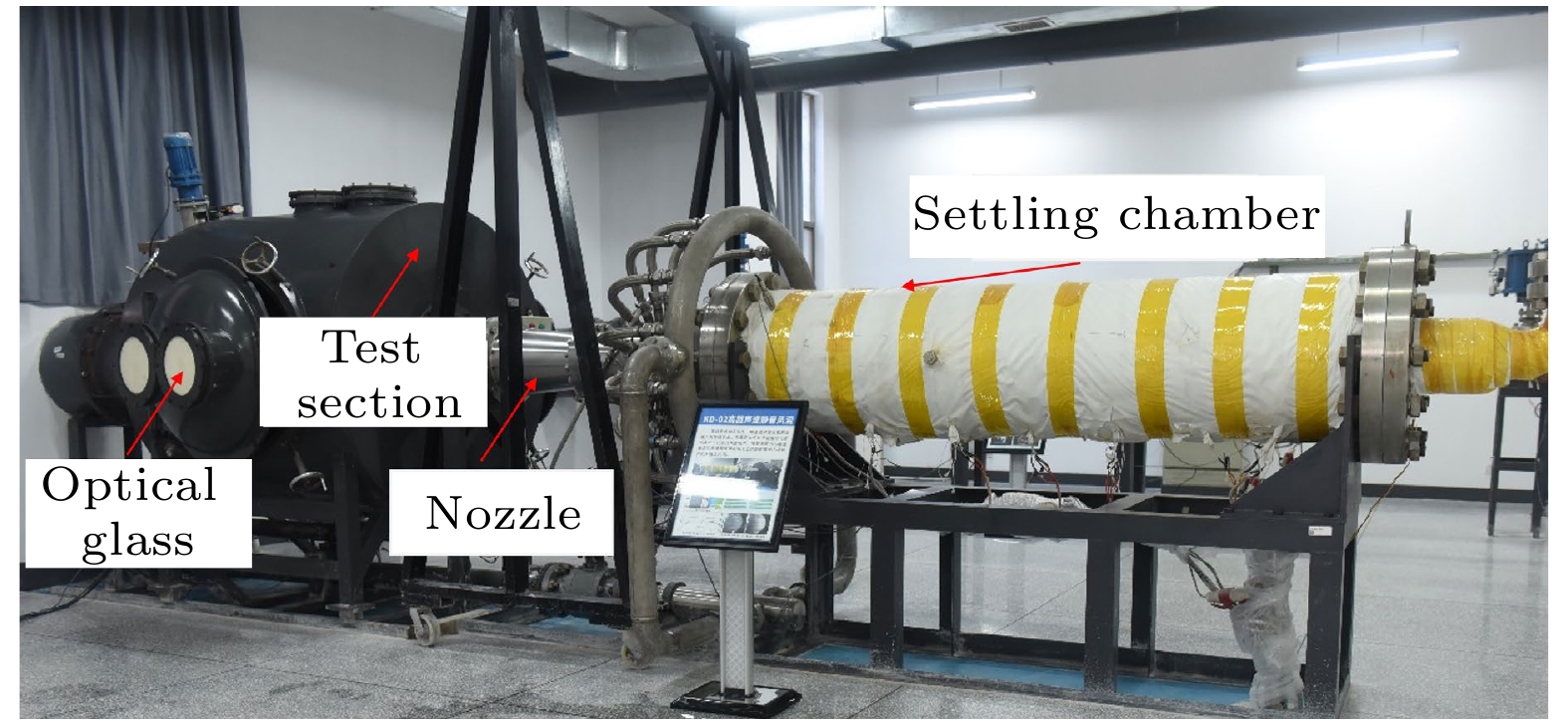
 下载:
下载:


